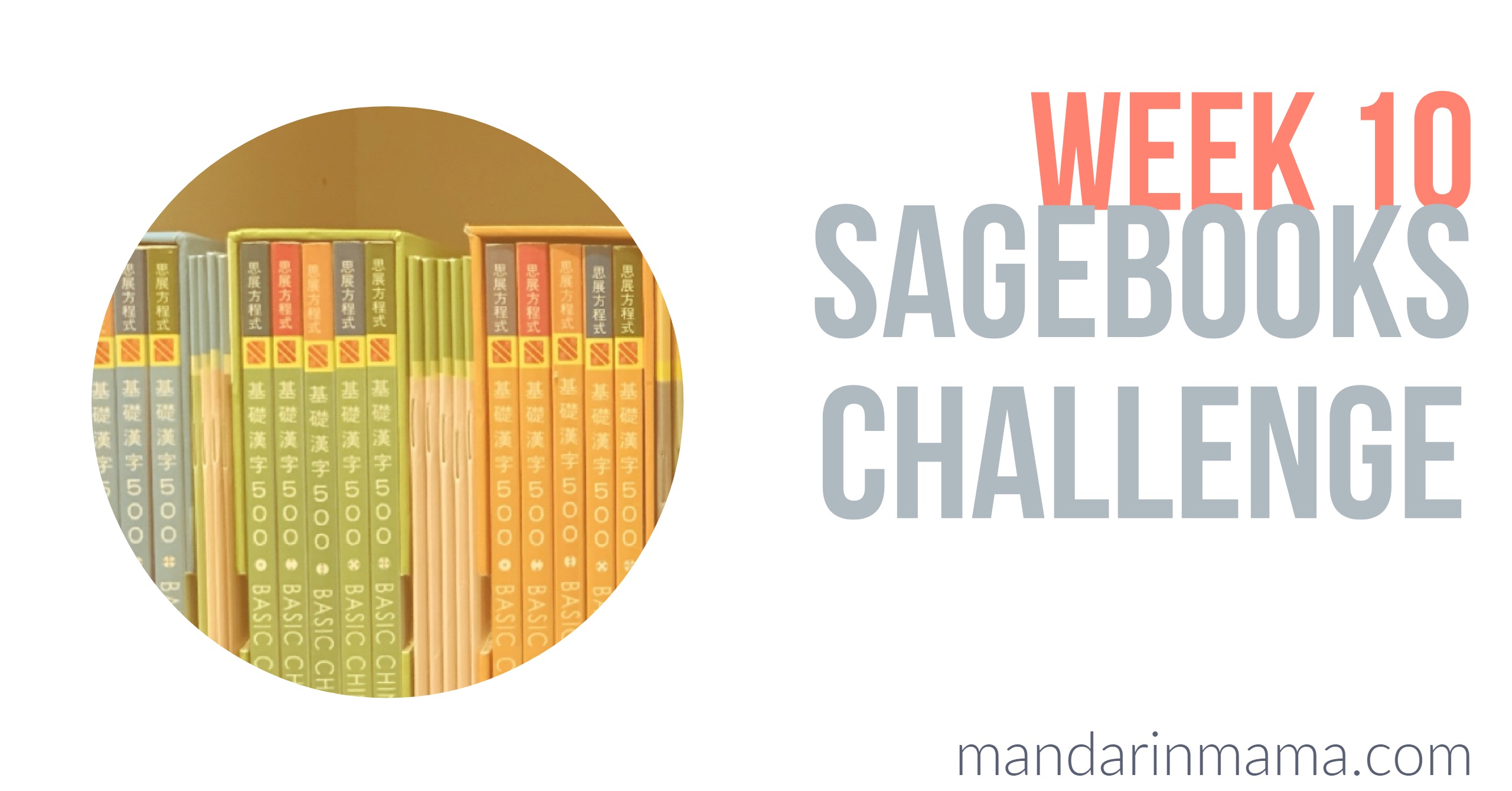*A/N: For more information and a basic background about Sagebooks, please refer to my previous posts or GuavaRama’s previous posts. This post is part of a mini-series on Sagebooks and might not make as much sense without context.
After last week’s post, a non-zero number of people have asked me whether or not I was sure that Sagebooks is inappropriate for non-speakers. I understand the impulse. After all, I’ve just raved on and on about Sagebooks and I did a good job because now these folks really want their kids to use Sagebooks to help them learn the 500 most frequently used characters in children’s books. But then, I specifically state that non-speaking kids aren’t going to benefit from them.
How utterly frustrating.
But honestly, you are doing your non-speaking child a great disservice if you are using Sagebooks as a means to teach them Chinese. There are far better materials out there that are specifically designed for non-speakers in a non-native environment.
Also, I should clarify that even if you do not personally recognize written characters, as long as you can speak and understand relatively fluently, you will be fine. There is pinyin on top of each character and an English translation beneath so you can follow the story. Plus, you will learn, too! (And even if you don’t, your kids will.)
Here then, are some reasons why I am so insistent that Sagebooks is only truly helpful for kids who are already fluent:
1) There simply isn’t enough repetition or useful phrases and words for a person to learn Chinese efficiently.
For instance: the first character Sagebooks teaches is 山 (shan/mountain). The second character is 高 (gao/tall, high) so that children can read their first sentence: 高山 (gao shan/tall mountain).
How is this remotely useful for someone learning a language for the first time?
There is a reason why most new language courses start with teaching conversational basics such as, “Hello” or “My name is” or “How are you?” or numbers. The whole purpose of learning a new language is to effectively communicate – and “tall mountain” will have a limited range of application.
So unless you just want your kids to learn random Chinese characters and have them be able to pronounce (I wouldn’t use “read” because “read” implies comprehension) a bunch of them without understanding their meaning, there are better uses for your time (~18 months + 3 months for shipping), money ($250-300), and effort (substantial). Keep in mind: Sagebooks only provides pinyin and an English translation of the content. It does not provide a word for word translation.
This would be like a non-English speaker learning how to read English (ie: using phonics to read) but not having the vocabulary or comprehension level to understand what they were reading. Or, like me, a non-German speaker, thinking I can “read” German because English has a shared alphabet.
Reading without comprehension is meaningless.
2) Chinese comprehension matters with Sagebooks.
For example, Cookie Monster had a hard time remembering the more abstract terms like 終於 (zhong yu2/finally) and 到處 (dao4 chu4/everywhere). After several days, I finally had a breakthrough and realized he might be having a hard time remembering the characters because he didn’t know what they meant. That’s why he couldn’t guess the words contextually. When I translated them into English, he could finally remember the characters.
I started noticing that if the characters were words that I rarely or never used with the kids, Cookie Monster had a hard time recalling the characters. He would have an incredibly difficult time – sometimes taking as long as a week to finally have the word click. Even when I broke down a character into its components, he would only remember the components, not the actual word.
For instance, it had been almost a week and he just couldn’t recall 連 (lian2/to join, connect). Just that it has 車 (che/car) in it. It was hard for me to explain because in the context, Sagebooks used 連忙 (lian2 mang2/hastily). I had never heard of the term. But once I realized the character was also used in 連起來 (lian2 qi3 lai2/connect together), I could explain.
Unfortunately, Cookie Monster still couldn’t remember. In fact, he didn’t consistently recall the character until we learned 運 (yun4/transport) – which is the almost the exact same character but with a “冖” component. I don’t know why, but that’s when it finally hit him – 2.5 books later.
The funny thing is, after figuring out what was going on with Cookie Monster, I realized I had the same problem! If I don’t commonly use the terms or had never heard of them, it is very difficult for me to remember the characters.
I have found as I’m going through Sagebooks with the kids that no matter how hard/difficult a character seems to me, that isn’t the determining factor for whether or not they retain it. Often, it is a matter of them actually knowing or comprehending the words. So if it’s a character that they understand or use often, they will remember. If it’s a character they’ve never heard of, they won’t.
You would think that 醫生 (yi sheng/doctor) would be a very difficult word to read. I certainly have a hard time with it! However, because Cookie Monster knows what a doctor is in Chinese, he has no problem remembering the character. It is a breeze.
3) The characters are symbols for words the kids already understand and know.
Actually, that is all that reading is, right? All written language is symbolic. The physical components represent spoken words and concepts. This is even more so in the Chinese written language where all the characters are literally symbols/glyphs.
How is this pertinent? Well, in a phonetic language like English, you phonetically sound out the letters in a word to “read” it. Even if you do not know the meaning of a word, you can still read it. However, in Chinese, the word is literally a symbol. You either know the character or you don’t. You cannot “sound it out.” Thus, if you do not understand Chinese, the symbols cannot be appropriately associated with the word.
For instance, I don’t know why but when speaking, Cookie Monster always confuses the word 麵 (mian4/noodle) for 飯 (fan4/cooked rice). So, when he learned the character 飯 (fan4), he always read it as 麵 (mian4). Cookie Monster would make the same mistakes reading as he did while speaking.
Relatedly, in words which are composed of multiple characters, both Cookie Monster and Gamera sometimes mis-read a character for its adjacent characters. For example:
– Reading 邊(bian1/side) when they see 旁(pang2/next to) because 旁邊 (pang2 bian) means, “on the side of.”
– Reading 衣 (yi/clothes) when they see 服 (fu2/clothes) because 衣服 (yi fu2) means, “clothing.”
– Reading 學 (xue2/learn) when they see 校 (xiao4/school) because 學校 means, “school.”
Both these examples confirm for me why comprehension is so important to reading.
(Also, I’m really butchering this explanation so I hope at some later point, I can be more coherent. Hopefully, you can still catch my meaning.)
4) By Set 5, there are a lot of 破音字 (po4 yin zi4/homograph) in use without any explanation.
破音字 are characters with two or more readings, or where different readings convey different meanings. An example of this in English would be the word, “august.”
– August (/ôɡəst/), with a capital “A” and pronounced with the emphasis on the first syllable, is the eighth month of the year.
– august (ôˈɡəst/), without a capital and pronounced with the emphasis on the last syllable, means respected and impressive.
(eg: In the month of August, I met a person of august parentage.)
Without Chinese comprehension, this would really screw up a kid’s reading because how would they know when to use which pronunciation unless they understood the surrounding context? The only way, then, to know when to use the correct pronunciation would be by memorizing all the word combinations that call for a particular pronunciation (which is likely, how teaching Chinese as a second language accomplishes this particular linguistic problem).
However, Sagebooks doesn’t provide any explanation for why different pronunciations are used, what the different meanings are, nor when to use them. That is not a good way to teach a second language.
My children, other than the initial stumbling over having alternate pronunciations of a character, can guess and accurately predict which iteration to use just through the story context alone. They have a broad enough vocabulary to immediately incorporate the alternate pronunciations and meanings in a way that makes sense and is grammatically correct.
Some examples of the po yin zi found in Sagebooks:
– 長 (chang2/tall); 長 (zhang3/to grow)
– 樂 (le4/happy); 樂 (yue4/music)
5) As if po yin zi weren’t confusing enough, there is also tonal sandhi to contend with.
Tonal sandhi is a linguistic term for when the tones of individual characters change depending on adjacent characters and their tones. Truthfully, I’m not even entirely clear on all the tonal sandhi rules for Mandarin. I mean, I couldn’t break it down for you if I tried (hence the Wikipedia links).
However, just as with po yin zi, my children instinctively know how to incorporate the rules of tonal sandhi while reading because they know how to speak the language and what the words sound like when speaking.
Tones are hard enough for a beginning Mandarin learner. Now, you’re going to have the tones change when they’re associated with the same character but it depends on its adjacent characters? That’s just mean.
I cannot repeat it enough: Sagebooks are not appropriate for non-speaking families.
If you don’t want to take my word for it, consider what MJ, one of my fellow moms in a Chinese learning FB group, had this to say about Sagebooks:
“I bought 2 of the books 3 years ago when my Chinese knowledge was nil. I was unable to learn from it. Now that I know some Chinese, I can use the book to teach my son. If I myself didn’t understand Chinese, I wouldn’t be able to teach anything from the book to my son in a meaningful way.”
Look. I’m not some fictional gatekeeper preventing you from Sagebooks in all its wonder and glory. You do not need my approval or opinion to do whatever you want to do. I am not even a non-speaker so I can’t give you my experience in that particular regard.
However, if you don’t actually want to believe my opinion, why are you reading this long and technical post about Sagebooks?
Look online at Sagebook’s YouTube Channel and if you think it works for you, then it works for you.
Have a great Friday!







